Clergy
This articleneeds additional citations forverification.(February 2021) |
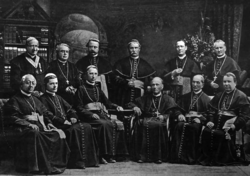
Clergyare formal leaders within establishedreligions.Their roles and functions vary in different religious traditions, but usually involve presiding over specific rituals and teaching their religion'sdoctrinesand practices. Some of the terms used for individual clergy areclergyman,clergywoman,clergyperson,churchman, cleric,ecclesiastic,andvicegerentwhileclerk in holy ordershas a long history but is rarely used.[citation needed]
InChristianity,the specific names and roles of the clergy vary bydenominationand there is a wide range of formal and informal clergy positions, includingdeacons,elders,priests,bishops,preachers,pastors,presbyters,ministers,and thepope.
InIslam,a religious leader is often known formally or informally as animam,caliph,qadi,mufti,mullah,muezzinandulema.
In theJewish tradition,a religious leader is often arabbi(teacher) orhazzan(cantor).
Etymology[edit]
The wordclericcomes from theecclesiastical LatinClericus,for those belonging to the priestly class. In turn, the source of the Latin word is from theEcclesiastical GreekKlerikos(κληρικός), meaning appertaining to an inheritance, in reference to the fact that theLeviticalpriests of theOld Testamenthad no inheritance except the Lord.[1]"Clergy" is from twoOld Frenchwords,clergiéandclergie,which refer to those with learning and derive fromMedieval Latinclericatus,fromLate Latinclericus(the same word from which "cleric" is derived).[2]"Clerk", which used to mean one ordained to the ministry, also derives fromclericus.In the Middle Ages, reading and writing were almost exclusively the domain of the priestly class, and this is the reason for the close relationship of these words.[3]WithinChristianity,especially inEastern Christianityand formerly in WesternRoman Catholicism,the termclericrefers to any individual who has been ordained, includingdeacons,priests,andbishops.[4]InLatin Catholicism,thetonsurewas a prerequisite for receiving any of theminor ordersormajor ordersbefore the tonsure,minor orders,and thesubdiaconatewere abolished following theSecond Vatican Council.[5]Now, the clerical state is tied to reception of the diaconate.[6]Minor Ordersare still given in theEastern Catholic Churches,and those who receive those orders are 'minor clerics.'[7]
The use of the wordclericis also appropriate forEastern Orthodoxminor clergy who are tonsured in order not to trivialize orders such as those of Reader in theEastern Church,or for those who are tonsured yet have no minor or major orders. It is in this sense that the word entered the Arabic language, most commonly in Lebanon from the French, askleriki(or, alternatively,cleriki) meaning "seminarian."This is all in keeping with Eastern Orthodox concepts of clergy, which still include those who have not yet received, or do not plan to receive, the diaconate.
A priesthood is a body ofpriests,shamans,ororacleswho have special religious authority or function. The term priest is derived from theGreekpresbyter(πρεσβύτερος,presbýteros,elder or senior), but is often used in the sense ofsacerdosin particular, i.e., for clergy performingritualwithin the sphere of thesacredornuminouscommunicating with thegodson behalf of the community.
Buddhism[edit]
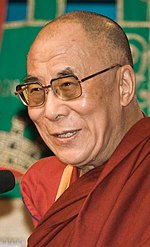
Buddhistclergy are often collectively referred to as theSangha,and consist of various orders of male and female monks (originally calledbhikshusandbhikshunisrespectively). This diversity of monastic orders and styles was originally one community founded byGautama Buddhaduring the 5th century BC living under a common set of rules (called theVinaya). According to scriptural records, these celibate monks and nuns in the time of the Buddha lived an austere life of meditation, living as wandering beggars for nine months out of the year and remaining in retreat during the rainy season (although such a unified condition ofPre-sectarian Buddhismis questioned by some scholars). However, as Buddhism spread geographically over time – encountering different cultures, responding to new social, political, and physical environments – this single form of Buddhist monasticism diversified. The interaction between Buddhism and TibetanBonled to a uniquelyTibetan Buddhism,within which various sects, based upon certain teacher-student lineages arose. Similarly, the interaction between Indian Buddhist monks (particularly of the SouthernMadhyamikaSchool) and ChineseConfucianandTaoistmonks from c200-c900AD produced the distinctiveCh'anBuddhism. Ch'an, like the Tibetan style, further diversified into various sects based upon the transmission style of certain teachers (one of the most well known being the 'rapid enlightenment' style ofLinji Yixuan), as well as in response to particular political developments such as theAn Lushan Rebellionand the Buddhist persecutions ofEmperor Wuzong.In these ways, manual labour was introduced to a practice where monks originally survived on alms; layers of garments were added where originally a single thin robe sufficed; etc. This adaptation of form and roles of Buddhist monastic practice continued after the transmission to Japan. For example, monks took on administrative functions for the Emperor in particular secular communities (registering births, marriages, deaths), thereby creating Buddhist 'priests'. Again, in response to various historic attempts to suppress Buddhism (most recently during theMeiji Era), the practice of celibacy was relaxed and Japanese monks allowed to marry. This form was then transmitted toKorea,during later Japanese occupation,[8]where celibate and non-celibate monks today exist in the same sects. (Similar patterns can also be observed in Tibet during various historic periods multiple forms of monasticism have co-existed such as "ngagpa"lamas, and times at which celibacy was relaxed). As these varied styles of Buddhist monasticism are transmitted to Western cultures, still more new forms are being created.
In general, theMahayanaschools of Buddhism tend to be more culturally adaptive and innovative with forms, whileTheravadaschools (the form generally practised inThailand,Burma,CambodiaandSri Lanka) tend to take a much more conservative view of monastic life, and continue to observe precepts that forbid monks from touching women or working in certain secular roles. This broad difference in approach led to a major schism among Buddhist monastics in about the 4th century BCE, creating theEarly Buddhist Schools.
While female monastic (bhikkhuni) lineages existed in most Buddhist countries at one time, theTheravadalineages of Southeast Asia died out during the 14th-15th Century AD. As there is some debate about whether the bhikkhuni lineage (in the more expansive Vinaya forms) was transmitted to Tibet, the status and future of female Buddhist clergy in this tradition is sometimes disputed by strict adherents to the Theravadan style. Some Mahayana sects, notably in the United States (such asSan Francisco Zen Center) are working to reconstruct the female branches of what they consider a common, interwoven lineage.[9]
The diversity of Buddhist traditions makes it difficult to generalize about Buddhist clergy. In the United States,Pure Landpriests of the Japanese diaspora serve a role very similar to Protestant ministers of the Christian tradition. Meanwhile, reclusive Theravada forest monks in Thailand live a life devoted to meditation and the practice of austerities in small communities in rural Thailand- a very different life from even their city-dwelling counterparts, who may be involved primarily in teaching, the study of scripture, and the administration of the nationally organized (and government sponsored) Sangha. In the Zen traditions of China, Korea and Japan, manual labor is an important part of religious discipline; meanwhile, in the Theravada tradition, prohibitions against monks working as laborers and farmers continue to be generally observed.
Currently in North America, there are both celibate and non-celibate clergy in a variety of Buddhist traditions from around the world. In some cases they are forest dwelling monks of the Theravada tradition and in other cases they are married clergy of a Japanese Zen lineage and may work a secular job in addition to their role in the Buddhist community. There is also a growing realization that traditional training in ritual and meditation as well as philosophy may not be sufficient to meet the needs and expectations of American lay people. Some communities have begun exploring the need for training in counseling skills as well. Along these lines, at least two fully accredited Master of Divinity programs are currently available: one atNaropa Universityin Boulder, CO and one at the University of the West in Rosemead, CA.
Titles for Buddhist clergy include:
In Theravada:
- Acharya
- Ajahn
- Anagarika
- Ayya
- Bhante
- Dasa sil mata
- Luang Por
- Maechi or Mae chee
- Phra
- Sayadaw
- Sikkhamānā
- Thilashin
In Mahayana:
In Vajrayana:
Christianity[edit]
In general, Christian clergy areordained;that is, they are set apart for specificministryin religious rites. Others who have definite roles in worship but who are not ordained (e.g.laypeopleacting asacolytes) are generally not considered clergy, even though they may require some sort of official approval to exercise these ministries.
Types of clerics are distinguished from offices, even when the latter are commonly or exclusively occupied by clerics. A Roman Catholic cardinal, for instance, is almost without exception a cleric, but a cardinal is not a type of cleric. An archbishop is not a distinct type of cleric, but is simply a bishop who occupies a particular position with special authority. Conversely, a youth minister at aparishmay or may not be a cleric. Different churches have different systems of clergy, though churches with similarpolityhave similar systems.
Anglicanism[edit]
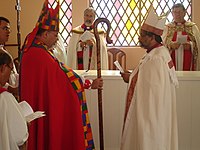
InAnglicanism,clergy consist of the orders ofdeacons,priests(presbyters) andbishopsin ascending order of seniority.Canon,archdeacon,archbishopand the like are specific positions within these orders. Bishops are typically overseers, presiding over adiocesecomposed of manyparishes,with an archbishop presiding over aprovincein most, which is a group of dioceses. A parish (generally a single church) is looked after by one or more priests, although one priest may be responsible for several parishes. New clergy are first ordained as deacons. Those seeking to become priests are usually ordained to the priesthood around a year later. Since the 1960s some Anglican churches have reinstituted the permanent diaconate, in addition to the transitional diaconate, as a ministry focused on bridges the church and the world, especially ministry to those on the margins of society.
For a short period of history before the ordination of women as deacons, priests and bishops began within Anglicanism, women could bedeaconesses.Although they were usually considered having a ministry distinct from deacons they often had similar ministerial responsibilities.
In Anglicanism all clergy are permitted to marry. In most national churches women may become deacons or priests, but while fifteen out of 38 national churches allow for the consecration of women as bishops, only five have ordained any. Celebration of theEucharistis reserved for priests and bishops.
National Anglican churches are presided over by one or moreprimatesormetropolitans(archbishops or presiding bishops). The senior archbishop of theAnglican Communionis theArchbishop of Canterbury,who acts as leader of theChurch of Englandand 'first among equals' of the primates of all Anglican churches.
Being a deacon, priest or bishop is considered a function of the person and not a job. When priests retire they are still priests even if they no longer have any active ministry. However, they only hold the basic rank after retirement. Thus a retired archbishop can only be considered a bishop (though it is possible to refer to "Bishop John Smith, the former Archbishop of York" ), a canon or archdeacon is a priest on retirement and does not hold any additional honorifics.
For the forms of address for Anglican clergy, seeForms of address in the United Kingdom.
-
Sir George Fleming, 2nd Baronet,British churchman.
-
Charles Wesley Leffingwell,Episcopal priest
Baptist[edit]
TheBaptisttradition only recognizes two ordained positions in the church as being the elders (pastors) and deacons as outlined in the third chapter of I Timothy[10]in the Bible.
Catholic Church[edit]
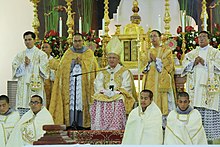
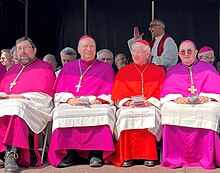
Ordainedclergy in theCatholic Churchare either deacons, priests, or bishops belonging to the diaconate, the presbyterate, or the episcopate, respectively. Among bishops, some aremetropolitans,archbishops,orpatriarchs.Thepopeis thebishop of Rome,the supreme and universal hierarch of the Church, and his authorization is now required for the ordination of all Roman Catholic bishops. With rare exceptions,cardinalsare bishops, although it was not always so; formerly, some cardinals were people who had receivedclerical tonsure,but notHoly Orders.Secular clergyare ministers, such as deacons and priests, who do not belong to a religious institute and live in the world at large, rather than a religious institute (saeculum). TheHoly Seesupports the activity of its clergy by theCongregation for the Clergy([1]), adicasteryofRoman curia.
Canon Lawindicates (canon 207) that "[b]y divine institution, there are among the Christian faithful in the Church sacred ministers who in law are also called clerics; the other members of the Christian faithful are called lay persons".[11]This distinction of a separate ministry was formed in the early times of Christianity; one early source reflecting this distinction, with the three ranks or orders ofbishop,priestanddeacon,is the writings of SaintIgnatius of Antioch.
Holy Orders is one of theSeven Sacraments,enumerated at theCouncil of Trent,that the Magisterium considers to be of divine institution. In the Catholic Church, only men are permitted to be clerics.[citation needed]
In theLatin Churchbefore 1972,tonsureadmitted someone to the clerical state, after which he could receive the fourminor orders(ostiary, lectorate, order of exorcists, order of acolytes) and then themajor ordersofsubdiaconate,diaconate, presbyterate, and finally the episcopate, which according to Roman Catholic doctrine is "the fullness of Holy Orders". Since 1972 the minor orders and the subdiaconate have been replaced bylay ministriesand clerical tonsure no longer takes place, except in someTraditionalist Catholicgroups, and the clerical state is acquired, even in those groups, by Holy Orders.[12]In the Latin Church the initial level of the three ranks of Holy Orders is that of the diaconate. In addition to these three orders of clerics, someEastern Catholic,or "Uniate", Churches have what are called "minor clerics".[13]
Members ofinstitutes of consecrated lifeandsocieties of apostolic lifeare clerics only if they have received Holy Orders. Thus, unordained monks,friars,nuns,and religious brothers andsistersare not part of the clergy.
The Code of Canon Law and the Code of Canons of the Eastern Churches prescribe that every cleric must be enrolled or "incardinated"in adioceseor its equivalent (anapostolic vicariate,territorial abbey,personal prelature,etc.) or in areligious institute,society of apostolic lifeorsecular institute.[14][13]The need for this requirement arose because of the trouble caused from the earliest years of the Church by unattached or vagrant clergy subject to no ecclesiastical authority and often causing scandal wherever they went.[15]
Current canon law prescribes that to be ordained a priest, an education is required of two years ofphilosophyand four oftheology,including study of dogmatic and moral theology, the Holy Scriptures, and canon law have to be studied within aseminaryor an ecclesiastical faculty at a university.[16][17]
Clerical celibacyis a requirement for almost all clergy in the predominant Latin Church, with the exception of deacons who do not intend to become priests. Exceptions are sometimes admitted for ordination to transitional diaconate and priesthood on a case-by-case basis for married clergymen of other churches or communities who become Catholics, but consecration of already married men asbishopsis excluded in both the Latin andEastern Catholic Churches(seepersonal ordinariate).Clerical marriageis not allowed and therefore, if those for whom in someparticular Churchcelibacy is optional (such as permanent deacons in the Latin Church) wish to marry, they must do so before ordination. Eastern Catholic Churches while allowing married men to be ordained, do not allowclerical marriageafter ordination: theirparish priestsare often married, but must marry before being ordained to the priesthood.[18]Eastern Catholic Churchesrequire celibacy only for bishops.
Eastern Orthodoxy[edit]
| Part ofa serieson the |
| Eastern Orthodox Church |
|---|
| Overview |
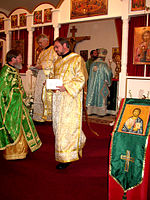
TheEastern Orthodox Churchhas three ranks of holy orders: bishop, priest, and deacon. These are the same offices identified in theNew Testamentand found in theEarly Church,as testified by the writings of theHoly Fathers.Each of these ranks is ordained through theSacred Mystery(sacrament) of thelaying on of hands(calledcheirotonia) by bishops. Priests and deacons are ordained by their owndiocesan bishop,while bishops areconsecratedthrough the laying on of hands of at least three other bishops.
Within each of these three ranks there are found a number of titles. Bishops may have the title ofarchbishop,metropolitan,andpatriarch,all of which are consideredhonorifics.Among the Orthodox, all bishops are considered equal, though an individual may have a place of higher or lower honor, and each has his place within theorder of precedence.Priests (also calledpresbyters) may (or may not) have the title ofarchpriest,protopresbyter(also called "protopriest", or "protopope" ),hieromonk(amonkwho has been ordained to the priesthood)archimandrite(a senior hieromonk) andhegumen(abbot). Deacons may have the title ofhierodeacon(a monk who has been ordained to the deaconate),archdeaconorprotodeacon.
The lower clergy are not ordained throughcheirotonia(laying on of hands) but through a blessing known ascheirothesia(setting-aside). These clerical ranks aresubdeacon,readerandaltar server(also known astaper-bearer). Some churches have a separate service for the blessing of acantor.
Ordination of a bishop, priest, deacon or subdeacon must be conferred during theDivine Liturgy(Eucharist)—though in some churches it is permitted to ordain up through deacon during theLiturgy of the Presanctified Gifts—and no more than a single individual can be ordained to the same rank in any one service. Numerous members of the lower clergy may be ordained at the same service, and their blessing usually takes place during theLittle Hoursprior to Liturgy, or may take place as a separate service. The blessing of readers and taper-bearers is usually combined into a single service. Subdeacons are ordained during the Little Hours, but the ceremonies surrounding his blessing continue through the Divine Liturgy, specifically during theGreat Entrance.
Bishops are usually drawn from the ranks of the archimandrites, and are required to be celibate; however, a non-monastic priest may be ordained to the episcopate if he no longer lives with his wife (following Canon XII of theQuinisext Council of Trullo)[19]In contemporary usage such a non-monastic priest is usuallytonsuredto the monastic state, and then elevated to archimandrite, at some point prior to his consecration to the episcopacy. Although not a formal or canonical prerequisite, at present bishops are often required to have earned a university degree, typically but not necessarily intheology.
Usual titles areYour Holinessfor a patriarch (withYour All-Holinessreserved for theEcumenical Patriarch of Constantinople),Your Beatitudefor an archbishop/metropolitan overseeing anautocephalous Church,Your Eminencefor an archbishop/metropolitan generally,MasterorYour Gracefor a bishop andFatherfor priests, deacons and monks,[20]although there are variations between the various Orthodox Churches. For instance, in Churches associated with the Greek tradition, while the Ecumenical Patriarch is addressed as "Your All-Holiness", all other Patriarchs (and archbishops/metropolitans who oversee autocephalous Churches) are addressed as "Your Beatitude".[21]
Orthodox priests, deacons, and subdeacons must be either married or celibate (preferably monastic) prior to ordination, but may not marry after ordination.Remarriage of clergy following divorce or widowhood is forbidden. Married clergy are considered as best-suited to staff parishes, as a priest with a family is thought better qualified to counsel his flock.[22]It has been common practice in the Russian tradition for unmarried, non-monastic clergy to occupy academic posts.
Methodism[edit]
In the Methodist Churches, candidates for ordination are "licensed" to the ministry for a period of time (typically one to three years) prior to being ordained. This period typically is spent performing the duties of ministry under the guidance, supervision, and evaluation of a more senior, ordained minister. In some denominations, however, licensure is a permanent, rather than a transitional state for ministers assigned to certain specialized ministries, such as music ministry or youth ministry.
Latter-day Saints[edit]
The Church of Jesus Christ of Latter-day Saints(LDS Church) has no dedicated clergy, and is governed instead by a system of lay priesthood leaders. Locally, unpaid and part-timepriesthood holderslead the church; the worldwide church is supervised by full-timegeneral authorities,some of whom receive modest living allowances.[23][24]No formal theological training is required for any position. The church believes that all of its leaders are called byrevelationand thelaying on of handsby one who holds authority. The church also believes thatJesus Christstands at the head of the church and leads the church through revelation given to thePresident of the Church,theFirst Presidency,andTwelve Apostles,all of whom are recognized asprophets, seers, and revelatorsand have lifetime tenure. Below these men in the hierarchy arequorumsofseventy,which are assigned geographically over theareasof the church. Locally, the church is divided intostakes;each stake has apresident,who is assisted by two counselors and ahigh council.The stake is made up of several individual congregations, which are called "wards"or" branches. "Wards are led by abishopand his counselors and branches by apresidentand his counselors. Local leaders serve in their positions until released by their supervising authorities.[25]
Generally, all worthy males age 12 and above receive thepriesthood.Youth age 12 to 18 are ordained to theAaronic priesthoodasdeacons,teachers,orpriests,which authorizes them to perform certainordinancesand sacraments. Adult males are ordained to theMelchizedek priesthood,aselders,seventies,high priests,orpatriarchsin that priesthood, which is concerned with spiritual leadership of the church. Although the term "clergy" is not typically used in the LDS Church, it would most appropriately apply to local bishops and stake presidents. Merely holding an office in the priesthood does not imply authority over other church members or agency to act on behalf of the entire church.
Lutheranism[edit]
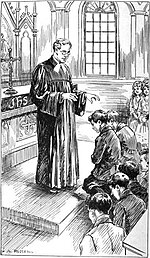
From a religious standpoint there is only one order of clergy in the Lutheran church, namely the office ofpastor.This is stated in theAugsburg Confession,article 14.[26]Some Lutheran churches, like the state churches of Scandinavia, refer to this office aspriest.
However, for practical and historical reasons, Lutheran churches tend to have different roles of pastors or priests, and a clear hierarchy. Some pastors are functioning asdeaconsor provosts, others as parish priests and yet some asbishopsand evenarchbishops.Lutherans have no principal aversion against having a pope as the leading bishop. But the Roman Catholic view of the papacy is considered antichristian.[27]
In many Europan churches where Lutheranism was thestate religion,the clergy were alsocivil servants,and their responsibilities extended well beyond spiritual leadership, encompassing government administration, education, and the implementation of government policies. Government administration was organized around the church's parishes. In rural parishes the parish priest tended to be the foremost government official. In more important parishes or cities a bishop or governor would outrank parish priests.
TheBook of Concord,a compendium of doctrine for theLutheran Churchesallows ordination to be called a sacrament.[citation needed]
Reformed[edit]
ThePresbyterian Church (U.S.A.)ordains two types ofpresbytersor elders, teaching (pastor) and ruling (leaders of the congregation which form a council with the pastors). Teaching elders are seminary trained and ordained as a presbyter and set aside on behalf of the whole denomination to the ministry of Word and Sacrament. Ordinarily, teaching elders are installed by a presbytery as pastor of a congregation. Ruling elders, after receiving training, may be commissioned by a presbytery to serve as a pastor of a congregation, as well as preach and administer sacraments.[28]
InCongregationalist Churches,local churches are free to hire (and often ordain) their own clergy, although the parent denominations typically maintain lists of suitable candidates seeking appointment to local church ministries and encourage local churches to consider these individuals when filling available positions.
Hinduism[edit]
AHindu priestmay refer to either of the following:
- APujari(IAST: Pūjārī) or an Archaka is aHindutemple priest.[29]
- APurohita(IAST: Purōhita) officiates and performs rituals and ceremonies, and is usually linked to a specific family or, historically, a dynasty.[30]
- AHindu Monk(IAST: Sādhu) is ascetic who renounced his worldly life and devoted toliberationfromcycle of life of birth, death and rebirth.An Sadhu is also calledSannyasa.Ascetics are both male and female. Their duty is preach religion to people.
- ABrahmachariis an person initiated into monasticism. He is a trainee and his duty is to learn and preach scriptures to people. Female initiate is called Brahmacharini.
Traditionally, priests have predominantly come from the Brahmana class, whose male members are designated for the function in theHindu texts.[32][33]
Hindupriests are known to perform prayer services, often referred to aspuja.Priests are identified aspanditsorpujarisamongst the devotees.[34]
Islam[edit]
Islam,likeJudaism,has no clergy in thesacerdotalsense; there is no institution resembling the Christian priesthood. Islamic religious leaders do not "serve as intermediaries between mankind and God",[35]have "process of ordination",[36]nor "sacramental functions".[35]They have been said to resemble more rabbis, serving as "exemplars, teachers, judges, and community leaders," providing religious rules to the pious on "even the most minor and private" matters.[35]
The titlemullah(a Persian variation of the Arabicmaula,"master" ), commonly translated "cleric" in the West and thought to be analogous to "priest" or "rabbi", is a title of address for any educated or respected figure, not even necessarily (though frequently) religious. The titlesheikh( "elder" ) is used similarly.
Most of the religious titles associated with Islam are scholastic or academic in nature: they recognize the holder's exemplary knowledge of the theory and practice ofad-dín(religion), and do not confer any particular spiritual or sacerdotal authority. The most general such title is`alim(pl.`ulamah), or "scholar". This word describes someone engaged in advanced study of the traditional Islamic sciences(`ulum)at an Islamic university ormadrasah jami`ah.A scholar's opinions may be valuable to others because of his/her knowledge in religious matters; but such opinions should not generally be considered binding, infallible, or absolute, as the individual Muslim is directly responsible to God for his or her own religious beliefs and practice.
There is no sacerdotal office corresponding to the Christian priest or Jewishkohen,as there is no sacrificial rite of atonement comparable to theEucharistor theKorban.Ritual slaughterordhabihah,including thequrbanat`Idu l-Ad'ha,may be performed by any adult Muslim who is physically able and properly trained. Professional butchers may be employed, but they are not necessary; in the case of thequrban,it is especially preferable to slaughter one's own animal if possible.[37]
Sunni[edit]

The nearest analogue among Sunni Muslims to the parish priest or pastor, or to the "pulpitrabbi"of a synagogue, is called theimam khatib.This compound title is merely a common combination of two elementary offices: leader(imam)of the congregational prayer, which in most mosques is performed at the times of all daily prayers; and preacher(khatib)of the sermon orkhutbaof the obligatory congregational prayer at midday every Friday. Although either duty can be performed by anyone who is regarded as qualified by the congregation, at most well-established mosquesimam khatibis a permanent part-time or full-time position. He may be elected by the local community, or appointed by an outside authority – e.g., the national government, or thewaqfthat sustains the mosque. There is no ordination as such; the only requirement for appointment as animam khatibis recognition as someone of sufficient learning and virtue to perform both duties on a regular basis, and to instruct the congregation in the basics of Islam.
The titlehafiz(lit. "preserver" ) is awarded to one who has memorized the entire Qur'an, often by attending a special course for the purpose; theimam khatibof a mosque is frequently (though not always) ahafiz.
There are several specialist offices pertaining to the study and administration of Islamic law orshari`ah.A scholar with a specialty infiqhor jurisprudence is known as afaqih.Aqadiis a judge in an Islamic court. Amuftiis a scholar who has completed an advanced course of study which qualifies him to issue judicial opinions orfatawah.
Shia[edit]
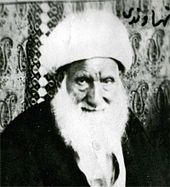
In modernShia Islam,scholars play a more prominent role in the daily lives of Muslims than in Sunni Islam; and there is a hierarchy of higher titles of scholastic authority, such asAyatollah.Since around the mid-19th century, a more complex title has been used inTwelverShi`ism, namelymarjaʿ at-taqlid.Marjaʿ(pl.marajiʿ) means "source", andtaqlidrefers to religious emulation or imitation. Lay Shi`ah must identify a specificmarjaʿwhom they emulate, according to his legal opinions(fatawah)or other writings. On several occasions, theMarjaʿiyyat(community of allmarajiʿ) has been limited to a single individual, in which case his rulings have been applicable to all those living in the Twelver Shi'ah world. Of broader importance has been the role of themujtahid,a cleric of superior knowledge who has the authority to performijtihad(independent judgment). Mujtahids are few in number, but it is from their ranks that themarajiʿ at-taqlidare drawn.
Sufism[edit]
The spiritual guidance function known in many Christian denominations as "pastoral care" is fulfilled for many Muslims by amurshid( "guide" ), a master of the spiritual sciences and disciplines known astasawuforSufism.Sufi guides are commonly styledShaikhin both speaking and writing; in North Africa they are sometimes calledmarabouts.They are traditionally appointed by their predecessors, in an unbroken teaching lineage reaching back toMuhammad.(The lineal succession of guides bears a superficial similarity to Christian ordination and apostolic succession, or to Buddhist dharma transmission; but a Sufi guide is regarded primarily as a specialized teacher and Islam denies the existence of an earthly hierarchy among believers.)
Muslims who wish to learn Sufism dedicate themselves to amurshid's guidance by taking an oath called abai'ah.The aspirant is then known as amurid( "disciple" or "follower" ). Amuridwho takes on special disciplines under the guide's instruction, ranging from an intensive spiritual retreat to voluntary poverty and homelessness, is sometimes known as adervish.
During theIslamic Golden Age,it was common for scholars to attain recognized mastery of both the "exterior sciences"(`ulum az-zahir)of the madrasahs as well as the "interior sciences"(`ulum al-batin)of Sufism.Al-GhazaliandRumiare two notable examples.
Ahmadiyya[edit]
The highest office an Ahmadi can hold is that ofKhalifatu l-Masih.Such a person may appoint amirs who manage regional areas.[38]The consultative body for Ahmadiyya is called theMajlis-i-Shura,which ranks second in importance to theKhalifatu l-Masih.[39]However, the Ahmadiyya community is declared asnon-Muslimsby many mainstream Muslims and they reject the messianic claims of Mirza Ghulam Ahmad.
Judaism[edit]

Rabbinic Judaismdoes not have clergy as such, although according to theTorahthere is a tribe of priests known as theKohanimwho were leaders of the religion up to thedestruction of the Temple of Jerusalemin 70 AD when mostSadduceeswere wiped out; each member of the tribe, a Kohen had priestly duties, many of which centered around the sacrificial duties, atonement and blessings of the Israelite nation. Today, Jewish Kohanim know their status by family tradition, and still offer the priestly blessing during certain services in the synagogue and perform thePidyon haben(redemption of the first-born son) ceremony.
Since the time of the destruction of the Temple of Jerusalem, the religious leaders of Judaism have often beenrabbis,who are technically scholars in Jewish law empowered to act as judges in arabbinical court.All types of Judaism except Orthodox Judaism allow women as well as men to be ordained as rabbis andcantors.[40][41]The leadership of a Jewish congregation is, in fact, in the hands of the laity: the president of a synagogue is its actual leader and any adult male Jew (or adult Jew in non-traditional congregations) can lead prayer services. The rabbi is not an occupation found in the Torah; the first time this word is mentioned is in theMishnah.The modern form of the rabbi developed in theTalmudicera. Rabbis are given authority to make interpretations ofJewish law and custom.Traditionally, a man obtains one of three levels ofSemicha(rabbinic ordination) after the completion of an arduous learning program in Torah,Tanakh(Hebrew Bible), Mishnah and Talmud,Midrash,Jewish ethics and lore, the codes ofJewish lawandresponsa,theologyandphilosophy.

Since the early medieval era an additional communal role, theHazzan(cantor) has existed as well. Cantors have sometimes been the only functionaries of a synagogue, empowered to undertake religio-civil functions like witnessing marriages. Cantors do provide leadership of actual services, primarily because of their training and expertise in the music and prayer rituals pertaining to them, rather than because of any spiritual or "sacramental" distinction between them and the laity. Cantors as much as rabbis have been recognized by civil authorities in the United States as clergy for legal purposes, mostly for awarding education degrees and their ability to perform weddings, and certify births and deaths.
Additionally, Jewish authorities licensemohalim,people specially trained by experts in Jewish law and usually also by medical professionals to perform the ritual of circumcision.[43]Traditional Orthodox Judaism does not generally license women as mohelot, unless a Jewish male expert is absent, but other movements of Judaism do. They are appropriately calledmohelot(pl. ofmohelet,f. of mohel).[43]As thej., the Jewish News Weekly of Northern California,states, "...there is no halachic prescription against female mohels, [but] none exist in the Orthodox world, where the preference is that the task be undertaken by a Jewish man.".[43]In many places, mohalim are also licensed by civil authorities, as circumcision is technically a surgical procedure. Kohanim, who must avoid contact with dead human body parts (such as the removed foreskin) for ritual purity, cannot act as mohalim,[citation needed]but some mohalim are also either rabbis or cantors.
Another licensed cleric in Judaism is theshochet,who are trained and licensed by religious authorities forkosherslaughter according to ritual law. A Kohen may be a shochet. Most shochetim are ordained rabbis.[44]
Then there is themashgiach/mashgicha.Mashgichimare observant Jews who supervise thekashrutstatus of a kosher establishment. Themashgichimmust know the Torah laws ofkashrut,and how they apply in the environment they are supervising. This can vary. In many instances, themashgiach/mashgichais a rabbi. This helps, since rabbinical students learn the laws of kosher as part of their syllabus. However, not allmashgichimare rabbis, and not all rabbis are qualified to bemashgichim.
Orthodox Judaism[edit]
In contemporary Orthodox Judaism, women are usually forbidden from becoming rabbis or cantors.[citation needed]Most Orthodox rabbinical seminaries or yeshivas also require dedication of many years to education, but few require a formal degree from a civil education institution that often define Christian clergy. Training is often focused on Jewish law, and some Orthodox Yeshivas forbid secular education.
InHasidic Judaism,generally understood as a branch of Orthodox Judaism, there are dynastic spiritual leaders known asRebbes,often translated in English as "Grand Rabbi". The office of Rebbe is generally a hereditary one, but may also be passed from Rebbe to student or by recognition of a congregation conferring a sort of coronation to their new Rebbe. Although one does not need to be an ordained Rabbi to be a Rebbe, most Rebbes today are ordained Rabbis. Since one does not need to be an ordained rabbi to be a Rebbe, at some points in history there were female Rebbes as well, particularly theMaiden of Ludmir.
Conservative Judaism[edit]
InConservative Judaism,both men and women are ordained as rabbis and cantors. Conservative Judaism differs with Orthodoxy in that it sees Jewish Law as binding but also as subject to many interpretations, including more liberal interpretations. Academic requirements for becoming a rabbi are rigorous. First earn a bachelor's degree before entering rabbinical school. Studies are mandated in pastoral care and psychology, the historical development of Judaism and most importantly the academic study of Bible, Talmud andrabbinic literature,philosophy and theology, liturgy, Jewish history, and Hebrew literature of all periods.
Reconstructionist and Reform Judaism[edit]
Reconstructionist JudaismandReform Judaismdo not maintain the traditional requirements for study as rooted in Jewish Law and traditionalist text. Both men and women may be rabbis or cantors. The rabbinical seminaries of these movements hold that one must first earn a bachelor's degree before entering the rabbinate. In addition studies are mandated in pastoral care and psychology, the historical development of Judaism; and academic biblical criticism. Emphasis is placed not on Jewish law, but rather on sociology, modern Jewish philosophy, theology and pastoral care.
Sikhism[edit]
Sikhclergy consists of fiveJathedars,one each from fivetakhtsor sacred seats. TheJathedarsare appointed by theShiromani Gurdwara Parbandhak Committee(SGPC), an elected body of the Sikhs sometimes called the "Parliament of Sikhs." The highest seat of the Sikh religion is calledAkal Takhtand theJathedarofAkal Takhtmakes all the important decisions after consultations with theJathedarsof the other fourtakhtsand the SGPC.
Zoroastrianism[edit]
MobadandMagiare Clergy ofZoroastrianism.Kartirwas one of the powerful and influential of them.
Traditional religions[edit]
Historicallytraditional(orpagan) religions typically combine religious authority and political power. What this means is that thesacred king or queenis therefore seen to combine both kingship and priesthood within his or her person, even though he or she is often aided by an actual high priest or priestess (see, for example, theMaya priesthood). When the functions of political ruler and religious leader are combined in this way,deificationcould be seen to be the next logical stage of his or her social advancement within his or her native environment, as is found in the case of the EgyptianPharaohs.TheVedic priesthoodof India is an early instance of a structured body of clergy organized as a separate and hereditary caste, one that occupied the highest social rung of its nation. A modern example of this phenomenon the priestly monarchs of theYorubaholy city ofIle-IfeinNigeria,whose reigningOnishave performed ritual ceremonies for centuries for the sustenance of the entire planet and its people.
Health risks for ministry in the United States[edit]
In recent years, studies have suggested that American clergy in certainProtestant,EvangelicalandJewishtraditions are more at risk than the general population of obesity, hypertension and depression.[citation needed]Their life expectancies have fallen in recent years and in the last decade[when?]their use of antidepressants has risen.[citation needed]Several religious bodies in the United States (Methodist,Episcopal,BaptistandLutheran) have implemented measures to address the issue, throughwellnesscampaigns, for example – but also by simply ensuring that clergy take more time off.
This articleneeds additional citations forverification.(November 2022) |
It is unclear whether similar symptoms affect AmericanMuslimclerics, although an anecdotal comment by one American imam suggested that leaders of mosques may also share these problems.[45]
One exception to the findings of these studies is the case of AmericanCatholicpriests, who are required bycanon lawto take a spiritual retreat each year, and four weeks of vacation.[citation needed]Sociological studies at theUniversity of Chicagohave confirmed this exception; the studies also took the results of several earlier studies into consideration and included Roman Catholic priests nationwide.[46]It remains unclear whether American clergy in other religious traditions experience the same symptoms, or whether clergy outside the United States are similarly affected.[citation needed]
See also[edit]
References[edit]
- ^Harper, Douglas."cleric".Online Etymology Dictionary.Archivedfrom the original on 2016-10-29 – via etymonline.
- ^Harper, Douglas."clergy".Online Etymology Dictionary.Archivedfrom the original on 2016-10-29 – via etymonline.
- ^Harper, Douglas."clerk".Online Etymology Dictionary.Archivedfrom the original on 2016-10-29 – via etymonline.
- ^"Cleric".Catholic Encyclopedia.Archivedfrom the original on 2018-08-20 – via newadvent.org.
- ^Paul VI, Apostolic lettermotu proprioMinisteria quaedamnos. 2–4, 64 AAS 529 (1972).
- ^Ministeria quaedamno. 1; CIC Canon 266 § 1.
- ^Nedungatt, George (2002). "Clerics".A Guide to the Eastern Code.CCEO Canon 327. pp. 255, 260.
- ^Korean Buddhism#Buddhism during Japanese colonial rule
- ^"Names of Women Ancestors"(PDF).Archived fromthe original(PDF)on 2011-11-17.Retrieved2013-10-23.
- ^1Tim 3
- ^"Code of Canon Law, Canon 207".Archivedfrom the original on 12 March 2020.Retrieved25 November2011.
- ^"Ministeria quaedam - Disciplina circa Primam Tonsuram, Ordines Minores et Subdiaconatus in Ecclesia Latina innovatur, Litterae Apostolicae Motu Proprio datae, Die 15 m. Augusti a. 1972, Paulus PP.VI - Paulus PP. VI".The Holy See.Archivedfrom the original on 2011-11-03.Retrieved2020-03-15.
- ^ab"Codex Canonum Ecclesiarum orientalium, die XVIII Octobris anno MCMXC - Ioannes Paulus PP. II - Ioannes Paulus II".The Holy See.Archivedfrom the original on 2011-06-04.Retrieved2020-03-15.
- ^"Code of Canon Law - IntraText".The Holy See.Archivedfrom the original on 2021-01-25.Retrieved2020-03-15.
- ^John P. Beal, James A. Coriden, Thomas J. Green,New Commentary on the Code of Canon Law(Paulist Press 2002ISBN9780809140664), p. 329
- ^"Code of Canon Law - IntraText".The Holy See.Archivedfrom the original on 2011-05-08.Retrieved2020-03-15.
- ^"Code of Canons of the Eastern Churches, canons 342-356".Archivedfrom the original on 2011-06-04.Retrieved2020-03-15.
- ^W. Braumüller, W. (2006).The Rusyn-Ukrainians of Czechoslovakia: An Historical Survey.University of Michigan Press. p. 17.ISBN9783700303121.
- ^Nicene and Post-Nicene FathersCCEL.orgArchived2005-07-20 at theWayback Machine
- ^"Clergy EtiquetteArchived2009-11-22 at theWayback Machine",Orthodox Christian Information Center.
- ^"Forms of Addresses and Salutations for Orthodox Clergy".Greek Orthodox Archdiocese of America.Archived fromthe originalon Feb 6, 2017.
- ^Ken Parry, David Melling, Dimitri Brady, Sidney Griffith & John Healey (eds.), 1999,The Blackwell Dictionary of Eastern Christianity,Oxford, pp116-7
- ^"Questions and Answers - ensign".ChurchofJesusChrist.org.Archivedfrom the original on 2020-02-19.Retrieved2019-07-15.
- ^"General Authorities,"Archived2014-11-11 at theWayback MachineEncyclopedia of Mormonism,p. 539
- ^The Church of Jesus Christ of Latter-day Saints,"Why Don't Mormons Have Paid Clergy?"Archived2014-05-08 at theWayback Machine,mormon.org.
- ^"The Augsburg Confession".gutenberg.org.Archivedfrom the original on 2021-06-24.Retrieved2022-02-07.
- ^"Power and Primacy of the Pope (1537): Smalcald Theologians".projectwittenberg.org.Archivedfrom the original on 2022-02-07.Retrieved2022-02-07.
- ^Presbyterian Church (U.S.A.).Book of Order: 2009-2011(Louisville: Office of the General Assembly), Form of Government, Chapter 6 and 14. See also"Theology and Worship"(PDF).Archived fromthe original(PDF)on 2004-03-07.
- ^wisdomlib.org (2018-09-23)."Arcaka: 11 definitions".wisdomlib.org.Archivedfrom the original on 2022-09-28.Retrieved2022-09-28.
- ^wisdomlib.org (2014-08-03)."Purohita: 24 definitions".wisdomlib.org.Archivedfrom the original on 2022-09-20.Retrieved2022-09-18.
- ^https:// chinmayamission /who-we-are/acharyas/
- ^Dubois, Jean Antoine; Beauchamp, Henry King (1897).Hindu Manners, Customs and Ceremonies.Clarendon Press. p. 15.Archivedfrom the original on 2023-12-24.Retrieved2023-12-24.
- ^Gandhi, Dr Srinivasan (2018-09-05).Hinduism And Brotherhood.Notion Press. p. 266.ISBN978-1-64324-834-9.Archivedfrom the original on 2023-12-24.Retrieved2023-12-24.
- ^"Hindu Religious Worker Definitions".Hindu American Foundation.Archivedfrom the original on 24 June 2021.Retrieved23 June2021.
- ^abcPipes, Daniel (1983).In the Path of God: Islam and Political Power.Routledge. p. 38.ISBN9781351512916.Archivedfrom the original on 18 March 2024.Retrieved5 June2018.
- ^Brown, Jonathan A.C.(2014).Misquoting Muhammad: The Challenge and Choices of Interpreting the Prophet's Legacy.Oneworld Publications.p.24.ISBN978-1780744209.Retrieved4 June2018.
- ^"Qurbani Meat Distribution Rules".Muslim Aid.Archivedfrom the original on 2022-08-22.Retrieved2022-08-22.
- ^The Muslim Resurgence in Ghana Since 1950: Nathan Samwini - 2003 p151
- ^Islam and the Ahmadiyya Jamaʻat: History, Belief, Practice,p.93, Simon Ross Valentine, 2008.
- ^"Orthodox Women To Be Trained As Clergy, If Not Yet as Rabbis".Forward.21 May 2009.Archivedfrom the original on 6 December 2011.Retrieved3 September2013.
- ^"The Cantor".myjewishlearning.My Jewish Learning. Archived fromthe originalon 27 September 2010.Retrieved3 September2013.
- ^Klapheck, Elisa."Regina Jonas".The Shalvi/Hyman Encyclopedia of Jewish Women.Jewish Women's Archive.Archivedfrom the original on April 21, 2019.RetrievedAugust 30,2021– via jwa.org.
- ^abc"Making the cut".j., the Jewish News Weekly of Northern California.3 March 2006.Archivedfrom the original on 25 October 2012.Retrieved3 September2013– via jweekly.
- ^Grandin, Temple (1980)."Problems With Kosher Slaughter".International Journal for the Study of Animal Problems.1(6): 375–390.Archivedfrom the original on 2017-01-18.Retrieved2017-01-17– via The Humane Society of the United States.
- ^Vitello, Paul (2 August 2010)."Evidence Grows of Problem of Clergy Burnout".The New York Times.Archivedfrom the original on 9 October 2016.Retrieved24 February2017.
- ^ See A. M. Greeley,Priests: A Calling in Crisis(University of Chicago Press, 2004).
Further reading[edit]
Clergy in general[edit]
- Aston, Nigel.Religion and revolution in France, 1780-1804(CUA Press, 2000)
- Bremer, Francis J.Shaping New Englands: Puritan Clergymen in Seventeenth-Century England and New England(Twayne, 1994)
- Dutt, Sukumar.Buddhist monks and monasteries of India(London: G. Allen and Unwin, 1962)
- Farriss, Nancy Marguerite.Crown and clergy in colonial Mexico, 1759-1821: The crisis of ecclesiastical privilege(Burns & Oates, 1968)
- Ferguson, Everett.The Early Church at Work and Worship: Volume 1: Ministry, Ordination, Covenant, and Canon(Casemate Publishers, 2014)
- Freeze, Gregory L.The Parish Clergy in Nineteenth-Century Russia: Crisis, Reform, Counter-Reform(Princeton University Press, 1983)
- Haig, Alan.The Victorian Clergy(Routledge, 1984), in England
- Holifield, E. Brooks.God's ambassadors: a history of the Christian clergy in America(Wm. B. Eerdmans Publishing, 2007), a standard scholarly history
- Lewis, Bonnie Sue.Creating Christian Indians: Native Clergy in the Presbyterian Church(University of Oklahoma Press, 2003)
- Marshall, Peter.The Catholic Priesthood and the English Reformation(Clarendon Press, 1994)
- Osborne, Kenan B.Priesthood: A history of ordained ministry in the Roman Catholic Church(Paulist Press, 1989), a standard scholarly history
- Parry, Ken, ed.The Blackwell Companion to Eastern Christianity(John Wiley & Sons, 2010)
- Sanneh, Lamin. "The origins of clericalism in West African Islam".The Journal of African History17.01 (1976): 49–72.
- Schwarzfuchs, Simon.A concise history of the rabbinate(Blackwell, 1993), a standard scholarly history
- Zucker, David J.American rabbis: Facts and fiction(Jason Aronson, 1998)
Female clergy[edit]
- Amico, Eleanor B., ed.Reader's Guide to Women's Studies( Fitzroy Dearborn, 1998), pp 131–33; historiography
- Collier-Thomas, Bettye.Daughters of Thunder: Black Women Preachers and Their Sermons(1997).
- Flowers, Elizabeth H.Into the Pulpit: Southern Baptist Women and Power Since World War II(Univ of North Carolina Press, 2012)
- Maloney, Linda M. "Women in Ministry in the Early Church".New Theology Review16.2 (2013).
- Ruether, Rosemary Radford. "Should Women Want Women Priests or Women-Church?".Feminist Theology20.1 (2011): 63–72.
- Tucker, Ruth A. and Walter L. Liefeld.Daughters of the Church: Women and Ministry from New Testament Times to the Present(1987), historical survey of female Christian clergy
External links[edit]
- Herbermann, Charles, ed. (1913)..Catholic Encyclopedia.New York: Robert Appleton Company.
- "Church Administration"- The Church of Jesus Christ of Latter Day Saints.
- Wlsessays.net,Scholarly articles on Christian Clergy from the Wisconsin Lutheran Seminary Library
- University of the West,Buddhist M.Div.
- Naropa UniversityArchived2007-02-08 at theWayback Machine,Buddhist M.Div.
- National Association of Christian Ministers,Priesthood of All Believers: Explained and Supported in Scripture



